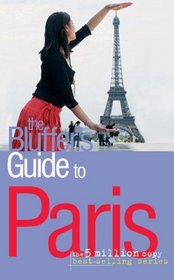Search -
The Bluffer's Guide to Paris (Bluffer's Guides)
The Bluffer's Guide to Paris - Bluffer's Guides
Author:
Mon DieuThe younger Alexandre Dumas (who should be referred to as "Alexandre Dumas fils" remarked that, ?God invented the Parisian to prevent foreigners from ever understanding anything about the French.? And all in all, he did a good job of it. You will never get a straight answer from a Parisian unless it happens to be a rude one: an... more » Something for the weekendThe real Montmartre, you will never tire of pointing out, the center of literary and artistic activity in the city towards the end of the last century, and still beautiful and relatively quiet, is located to the south-west of the Place du Tertre. Steep winding streets connected by flights of stone steps, small, inexpensive restaurants, including one of Paris's better-known vegetarian places on the rue des Trois Freres, called, wittily, Au Grain de Folie, little bars run by decrepit old couples, decaying hotels with paper-thin walls through which one can hear the activities of discerning couples on a dirty weekend or ?weekend amoureux? as the French more poetically call it: this is the real Montmartre. Taking the pissAnother legendary feature of Parisian ?sanitary? arrangements, now sadly entirely vanished, was the pissotiore (usually, though wrongly, known as ?a pissoir?). This, as its name graphically suggests, was a urinal found on street corners, and constructed from iron lattice-work in such a way that almost every part of the body, except for the bit actually being employed at the time, was visible to passers-by. It was generally considered that the pissotiores, or Vespasiens, as they were known (presumably because they dated from the reign of the Roman emperor Vespasian), lent a whiff of raffish charm to the Parisian street scene, though that of course was not the only thing they lent a whiff of. The French are always revoltingThe Revolution of 1830. This was a totally Parisian affair and quite implausibly romantic. Indeed, some see it as primarily the work of Victor Hugo, Berlioz, Madame de Stael, and Delacroix. In three glorious days during July, 1830, Charles X, the last of the Bourbons, was driven from Paris (to the strains of La Marseillaise?as effective then as it was in Casablanca), the Hotel de Ville was stormed, and a citizen king, Louis Philippe, was elected.
Author:
Mon DieuThe younger Alexandre Dumas (who should be referred to as "Alexandre Dumas fils" remarked that, ?God invented the Parisian to prevent foreigners from ever understanding anything about the French.? And all in all, he did a good job of it. You will never get a straight answer from a Parisian unless it happens to be a rude one: an... more » Something for the weekendThe real Montmartre, you will never tire of pointing out, the center of literary and artistic activity in the city towards the end of the last century, and still beautiful and relatively quiet, is located to the south-west of the Place du Tertre. Steep winding streets connected by flights of stone steps, small, inexpensive restaurants, including one of Paris's better-known vegetarian places on the rue des Trois Freres, called, wittily, Au Grain de Folie, little bars run by decrepit old couples, decaying hotels with paper-thin walls through which one can hear the activities of discerning couples on a dirty weekend or ?weekend amoureux? as the French more poetically call it: this is the real Montmartre. Taking the pissAnother legendary feature of Parisian ?sanitary? arrangements, now sadly entirely vanished, was the pissotiore (usually, though wrongly, known as ?a pissoir?). This, as its name graphically suggests, was a urinal found on street corners, and constructed from iron lattice-work in such a way that almost every part of the body, except for the bit actually being employed at the time, was visible to passers-by. It was generally considered that the pissotiores, or Vespasiens, as they were known (presumably because they dated from the reign of the Roman emperor Vespasian), lent a whiff of raffish charm to the Parisian street scene, though that of course was not the only thing they lent a whiff of. The French are always revoltingThe Revolution of 1830. This was a totally Parisian affair and quite implausibly romantic. Indeed, some see it as primarily the work of Victor Hugo, Berlioz, Madame de Stael, and Delacroix. In three glorious days during July, 1830, Charles X, the last of the Bourbons, was driven from Paris (to the strains of La Marseillaise?as effective then as it was in Casablanca), the Hotel de Ville was stormed, and a citizen king, Louis Philippe, was elected.
ISBN-13: 9781903096857
ISBN-10: 1903096855
Publication Date: 4/1/2007
Pages: 92
Rating: ?
ISBN-10: 1903096855
Publication Date: 4/1/2007
Pages: 92
Rating: ?
0 stars, based on 0 rating




